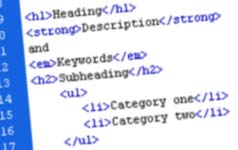
Observing the constantly increasing competition, it’s not surprising to see website owners seeking for ways that helps them survive the growing competition. Many site owners running a HTML website are opting for PSD to HTML conversion, in order to keep their site updated as per the latest design trends and customers needs. There are several reasons that makes a website owner choose this conversion.
First of all, the transformation helps a site owner give a fresh “look and feel” to their existing site, by designing a PSD with a new web design and unique approach. Secondly, since the transformation is mainly done with help of manual coding, you get a final theme that contains clean code that search engine crawlers can easily read. This means your web pages will easily get index by search engine bots, which leads to higher search engine ranking.
If you’re a designer and created a pixel-perfect PSD but can’t code, certainly you’ll choose to send your PSD files to some developer who can convert them into a fully-functional site. However, often we forget to pay heed to certain factors when designing the PSD or handing them off, which later creates issues and increases production time. Through this post I’ll be discussing about the 3 most important tips that will help you get enviable results from the conversion process.
1. Merge Layers Without Flattening
When designing a photoshop design designers tend to create different layers, empowering them to work on a particular design element without affecting the other design elements. But in certain situations, designers are required to merge the layers or make them flattened. While merging the layers merely combines the layers you’ve created into a single layer, on the other hand, flattening combines the layers into a single background layer to reduce the file size.
But you can’t combine the combine the layers in PSD to HTML conversion, as each and very layer contains some vital information for developers. For instance, the font layer determines font sizes, font families and other key elements. Flattening the layers will probably make it difficult for a new developer to work on the project in the absence of one who started the conversion process.
So, if you wish to merge the layers make sure not to flatten the layers. For this purpose, you can use a keyboard shortcut that is Ctrl+Alt+Shift+E. Sing the shortcut you’ll get new merged layer, but you’ll be able to view the original layers as well (that is present below the merged layer).
2. Hand-Off Organized PSD Files
Handing off unorganized PSD files can infuriate your developer and can substantially increase their time and effort – in looking for particular graphic layer, font layer and other layers. Besides, shoddy PSD files can give the developers a hard time in understanding how the actual website will look like once the design files gets converted. Your development partner will most likely have to spend more time in locating a particular layer, which will exceed the development time and eventually increases the cost of your project.
Organizing your layers by giving them names, and grouping them logically in terms of header, footer, sidebar etc. will make it easier for the developers to work on the PSD files without putting in much time and efforts. Also, make sure to arrange the groups of layers in accordance with the flow of your photoshop document. For instance, the header group generally comes at the top, footer group comes at the bottom of the page and so on.
Lastly, show the elements on grid; grid also referred to as vertical set of guidelines identify the shape of the elements and how they need to be placed. Not placing the elements on grid leads to additional steps when converting PSD files to HTML format.
3. Create Rollover Effects For CTA’s
CTA’s (call-to-action copy) have become indispensable part of a website. It helps determine how to place your call to action elements on a site. Adding call-to-action elements encourage visitors to solicit an action. These elements comprises of buttons, boxes etc. However, the most coveted form of call to action in sites is available in the form of call-to-action buttons. These buttons can get a hold of the visitors’ attention and entice them to hit the button. However, apart from CTA’s there is another factor that can elevate the click-through-rate of your site, called the rollover effect.
A CTA just comprises of an image containing a link. In contrast, the rollover effect tells that when an image is hovered by a user, some change occurs to the image – be it the color that is changed, lighting or saturation and so on.
No doubt, relevant content and good images are suffice to grab readers interests, however, when a link is rolled over and seeing it to be clickable can be an added advantage to your site that boosts the click-through-rate.
Conclusion
If you too are contemplating going for PSD to HTML conversion, then make sure to read the aforementioned tips when designing a photoshop design. This will help come up a great PSD that your service provider can easily convert into a functional HTML website.
About The Author
Deepu Balan
Hi there! I’m a web UI/UX architect. This is my online playground, my beautiful space to share my passions, my work and what I find inspiring.
